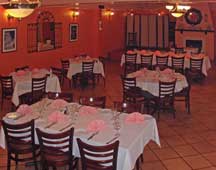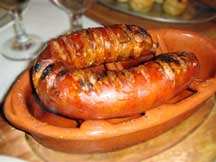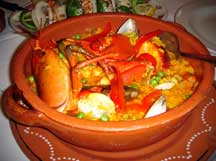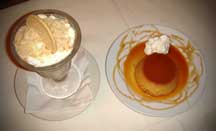| 718 Adams Avenue
Northeast Philadelphia
(215) 535-8700  One needn’t be Henry the Navigator to find this restaurant-sports bar just blocks off the Northeast’s Boulevard, in a small strip shopping mall. You enter what looks, at first, to be a shoddy shebang at parking lot level. You’ll discover a “sporting” area directly ahead. Above and behind a long neat wood bar, peopled by patrons primarily Portuguese, are flat-screen TV’s and a bevy of colorfully framed team “futbol” jerseys. The sound of “SCOOOO-O-O-O-OOORRRE” adds cheering smiles to the soccer-succoring game-gazing crowd. One needn’t be Henry the Navigator to find this restaurant-sports bar just blocks off the Northeast’s Boulevard, in a small strip shopping mall. You enter what looks, at first, to be a shoddy shebang at parking lot level. You’ll discover a “sporting” area directly ahead. Above and behind a long neat wood bar, peopled by patrons primarily Portuguese, are flat-screen TV’s and a bevy of colorfully framed team “futbol” jerseys. The sound of “SCOOOO-O-O-O-OOORRRE” adds cheering smiles to the soccer-succoring game-gazing crowd.
 Immediately to the right are wide stairs and a banister leading downward. A brief descent brings forth a copper-tinted tiled floor in a pink painted banquet room. This dining area is surprisingly full of light and of spacious proportions. All tables are covered by formal starched white tablecloths. “Baby-girl” pink napkins add frill. The noise from upstairs has disappeared. The “shh’s” you hear, here and there, are not meant to proscribe loudness, but are naturally emanating in the middle of and at the ends of words pronounced from the mouths of eaters speaking Portuguese among themselves. On Friday and Saturday evenings, you should enjoy a guitarist plying his fingers as if they were sailing through the Strait of Magellan. Immediately to the right are wide stairs and a banister leading downward. A brief descent brings forth a copper-tinted tiled floor in a pink painted banquet room. This dining area is surprisingly full of light and of spacious proportions. All tables are covered by formal starched white tablecloths. “Baby-girl” pink napkins add frill. The noise from upstairs has disappeared. The “shh’s” you hear, here and there, are not meant to proscribe loudness, but are naturally emanating in the middle of and at the ends of words pronounced from the mouths of eaters speaking Portuguese among themselves. On Friday and Saturday evenings, you should enjoy a guitarist plying his fingers as if they were sailing through the Strait of Magellan.
A gregarious and welcoming wait-staff arrives early and often with large multi-pointed Old World rolls accompanied by brined black unpitted olives. They also advise and warn that most entrées are sized toward stupendous, and ordering should be done with caution.  The appetizers should be shared, one for two. Never miss Chouriço Assado ($9), a flaming Portuguese sausage ten inches long and one inch thick, brought to the table alight in a ceramic brown-glazed canoe. Please be patient enough to allow the fire to expire (just a few seconds). Then cut into the sausage’s skin-splitting girth, carving ten crispy nuggets of bristling internal meats and granules of fattiness. Juices burst within your clenched cheeks as you attempt to gently gnarl the tender meld while holding your breath from the heat. Your tongue lashes in the bath, until a smoky garlic-laden swallow allows room for another forkful. The appetizers should be shared, one for two. Never miss Chouriço Assado ($9), a flaming Portuguese sausage ten inches long and one inch thick, brought to the table alight in a ceramic brown-glazed canoe. Please be patient enough to allow the fire to expire (just a few seconds). Then cut into the sausage’s skin-splitting girth, carving ten crispy nuggets of bristling internal meats and granules of fattiness. Juices burst within your clenched cheeks as you attempt to gently gnarl the tender meld while holding your breath from the heat. Your tongue lashes in the bath, until a smoky garlic-laden swallow allows room for another forkful.
Nor are the Codornizes Grelhadas ($8) to be avoided. Here are two grilled quails, served spread-eaglet on either end of an oblong platter, the middle of is which is piled with pickled vegetables, including carrots, beets and red peppers. The birds are to be eaten with hands. The quails’ bones are tiny, soft and pliant; easily ripped. The surrounding exposed meat is miniature and succulent. The vinegar-complemented legumes lend a sour serenity.  The most authentic dish, served and priced by weight in Lisbon, is Camarão à Guilho ($10), sautéed shrimp in white wine and garlic sauce. The peeled shrimp seem to curl in anticipation of your utensil’s touch. They’re steaming and plump, redolent of the garlic that perfumes their sheen. Served in a silver tureen topped with a crowning lemon wedge, they appear ready to be devoured by royalty. The most authentic dish, served and priced by weight in Lisbon, is Camarão à Guilho ($10), sautéed shrimp in white wine and garlic sauce. The peeled shrimp seem to curl in anticipation of your utensil’s touch. They’re steaming and plump, redolent of the garlic that perfumes their sheen. Served in a silver tureen topped with a crowning lemon wedge, they appear ready to be devoured by royalty.
I have failed to mention that with all of the above is served a huge bowl of salad for the table, of fresh baby lettuces, tomatoes and julienne carrot slivers. Remember to ask for more rolls and olives, and require that no raw onions appear. Now the entrées begin. Espetada de Lulas ($19) consists of a shish-kabob laden with grilled calamari the size of halos. The angelic bounce on the teeth is supplemented with devilishly delicious skewered shrimp, broccoli, carrots and green peppers. Heaven on earth grilled to perfidious perfection. Or consider Carne de Porco à Alentejana ($16). This platter provides blissfully bracing sautéed pork cubes embedded with clams over absorbent soft, squared, skinned potatoes. Cilantro is sprinkled as a coverlet, and the pork and clams become odd boisterous bedfellows. Aftertastes linger affectionately on your lips. Pousadas in Sintra and Setais serve no better.  The specialty of the house is “Paelha” ($20), served at Taste of Portugal in Saffron rice, aromatically embellished with seafood (Marinheira), or with some seafood, but mostly chicken, pork and sausage (Valenciana). Boundless lobster pieces (still in shells), shrimp (shelled), clams and mussels (attached to shells), calamari and scallops appear, as the market allows, in rounded brown ceramic Brasileira containers. The Paelha’s success is measured by the chef’s timing, so that all differing ingredients come to the table turgidly cooked, never over nor under. The attention to detail is relentless, and here, successful. The specialty of the house is “Paelha” ($20), served at Taste of Portugal in Saffron rice, aromatically embellished with seafood (Marinheira), or with some seafood, but mostly chicken, pork and sausage (Valenciana). Boundless lobster pieces (still in shells), shrimp (shelled), clams and mussels (attached to shells), calamari and scallops appear, as the market allows, in rounded brown ceramic Brasileira containers. The Paelha’s success is measured by the chef’s timing, so that all differing ingredients come to the table turgidly cooked, never over nor under. The attention to detail is relentless, and here, successful.
Fragrances replete with sea salt, shellfish and saffron accumulate in wet mounds of soaked rice. Amazingly sized, uneaten portions are inevitably packed and taken home for the next day’s lunch and dinner.  Dessert is a cold-hearted flan surrounded by the sweetest caramel. Dessert is a cold-hearted flan surrounded by the sweetest caramel.
VASCO DA GAMA | 


 One needn’t be Henry the Navigator to find this restaurant-sports bar just blocks off the Northeast’s Boulevard, in a small strip shopping mall. You enter what looks, at first, to be a shoddy shebang at parking lot level. You’ll discover a “sporting” area directly ahead. Above and behind a long neat wood bar, peopled by patrons primarily Portuguese, are flat-screen TV’s and a bevy of colorfully framed team “futbol” jerseys. The sound of “SCOOOO-O-O-O-OOORRRE” adds cheering smiles to the soccer-succoring game-gazing crowd.
One needn’t be Henry the Navigator to find this restaurant-sports bar just blocks off the Northeast’s Boulevard, in a small strip shopping mall. You enter what looks, at first, to be a shoddy shebang at parking lot level. You’ll discover a “sporting” area directly ahead. Above and behind a long neat wood bar, peopled by patrons primarily Portuguese, are flat-screen TV’s and a bevy of colorfully framed team “futbol” jerseys. The sound of “SCOOOO-O-O-O-OOORRRE” adds cheering smiles to the soccer-succoring game-gazing crowd. Immediately to the right are wide stairs and a banister leading downward. A brief descent brings forth a copper-tinted tiled floor in a pink painted banquet room. This dining area is surprisingly full of light and of spacious proportions. All tables are covered by formal starched white tablecloths. “Baby-girl” pink napkins add frill. The noise from upstairs has disappeared. The “shh’s” you hear, here and there, are not meant to proscribe loudness, but are naturally emanating in the middle of and at the ends of words pronounced from the mouths of eaters speaking Portuguese among themselves. On Friday and Saturday evenings, you should enjoy a guitarist plying his fingers as if they were sailing through the Strait of Magellan.
Immediately to the right are wide stairs and a banister leading downward. A brief descent brings forth a copper-tinted tiled floor in a pink painted banquet room. This dining area is surprisingly full of light and of spacious proportions. All tables are covered by formal starched white tablecloths. “Baby-girl” pink napkins add frill. The noise from upstairs has disappeared. The “shh’s” you hear, here and there, are not meant to proscribe loudness, but are naturally emanating in the middle of and at the ends of words pronounced from the mouths of eaters speaking Portuguese among themselves. On Friday and Saturday evenings, you should enjoy a guitarist plying his fingers as if they were sailing through the Strait of Magellan. The appetizers should be shared, one for two. Never miss Chouriço Assado ($9), a flaming Portuguese sausage ten inches long and one inch thick, brought to the table alight in a ceramic brown-glazed canoe. Please be patient enough to allow the fire to expire (just a few seconds). Then cut into the sausage’s skin-splitting girth, carving ten crispy nuggets of bristling internal meats and granules of fattiness. Juices burst within your clenched cheeks as you attempt to gently gnarl the tender meld while holding your breath from the heat. Your tongue lashes in the bath, until a smoky garlic-laden swallow allows room for another forkful.
The appetizers should be shared, one for two. Never miss Chouriço Assado ($9), a flaming Portuguese sausage ten inches long and one inch thick, brought to the table alight in a ceramic brown-glazed canoe. Please be patient enough to allow the fire to expire (just a few seconds). Then cut into the sausage’s skin-splitting girth, carving ten crispy nuggets of bristling internal meats and granules of fattiness. Juices burst within your clenched cheeks as you attempt to gently gnarl the tender meld while holding your breath from the heat. Your tongue lashes in the bath, until a smoky garlic-laden swallow allows room for another forkful. The most authentic dish, served and priced by weight in Lisbon, is Camarão à Guilho ($10), sautéed shrimp in white wine and garlic sauce. The peeled shrimp seem to curl in anticipation of your utensil’s touch. They’re steaming and plump, redolent of the garlic that perfumes their sheen. Served in a silver tureen topped with a crowning lemon wedge, they appear ready to be devoured by royalty.
The most authentic dish, served and priced by weight in Lisbon, is Camarão à Guilho ($10), sautéed shrimp in white wine and garlic sauce. The peeled shrimp seem to curl in anticipation of your utensil’s touch. They’re steaming and plump, redolent of the garlic that perfumes their sheen. Served in a silver tureen topped with a crowning lemon wedge, they appear ready to be devoured by royalty. The specialty of the house is “Paelha” ($20), served at Taste of Portugal in Saffron rice, aromatically embellished with seafood (Marinheira), or with some seafood, but mostly chicken, pork and sausage (Valenciana). Boundless lobster pieces (still in shells), shrimp (shelled), clams and mussels (attached to shells), calamari and scallops appear, as the market allows, in rounded brown ceramic Brasileira containers. The Paelha’s success is measured by the chef’s timing, so that all differing ingredients come to the table turgidly cooked, never over nor under. The attention to detail is relentless, and here, successful.
The specialty of the house is “Paelha” ($20), served at Taste of Portugal in Saffron rice, aromatically embellished with seafood (Marinheira), or with some seafood, but mostly chicken, pork and sausage (Valenciana). Boundless lobster pieces (still in shells), shrimp (shelled), clams and mussels (attached to shells), calamari and scallops appear, as the market allows, in rounded brown ceramic Brasileira containers. The Paelha’s success is measured by the chef’s timing, so that all differing ingredients come to the table turgidly cooked, never over nor under. The attention to detail is relentless, and here, successful. Dessert is a cold-hearted flan surrounded by the sweetest caramel.
Dessert is a cold-hearted flan surrounded by the sweetest caramel.